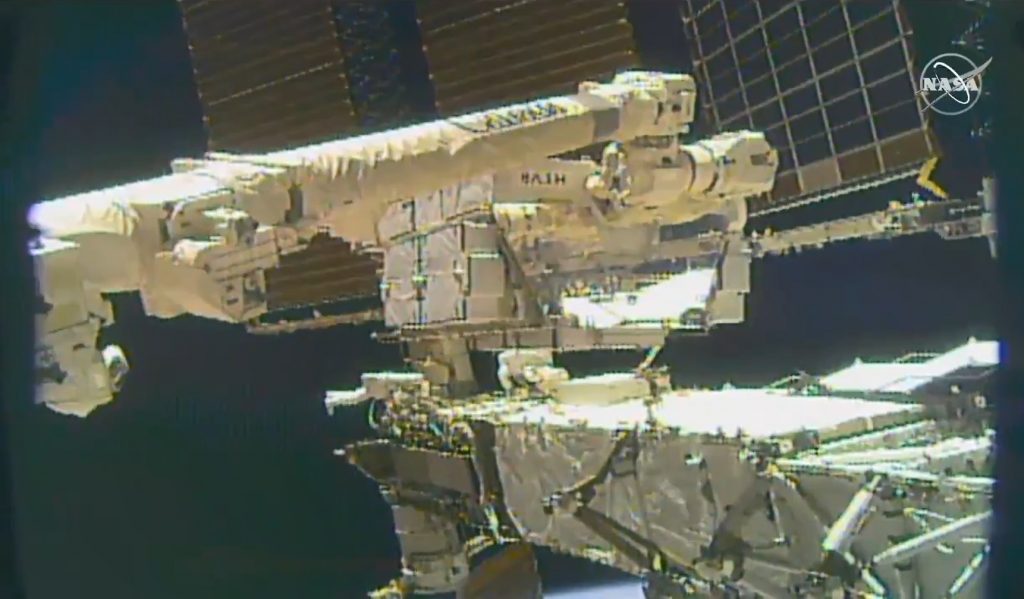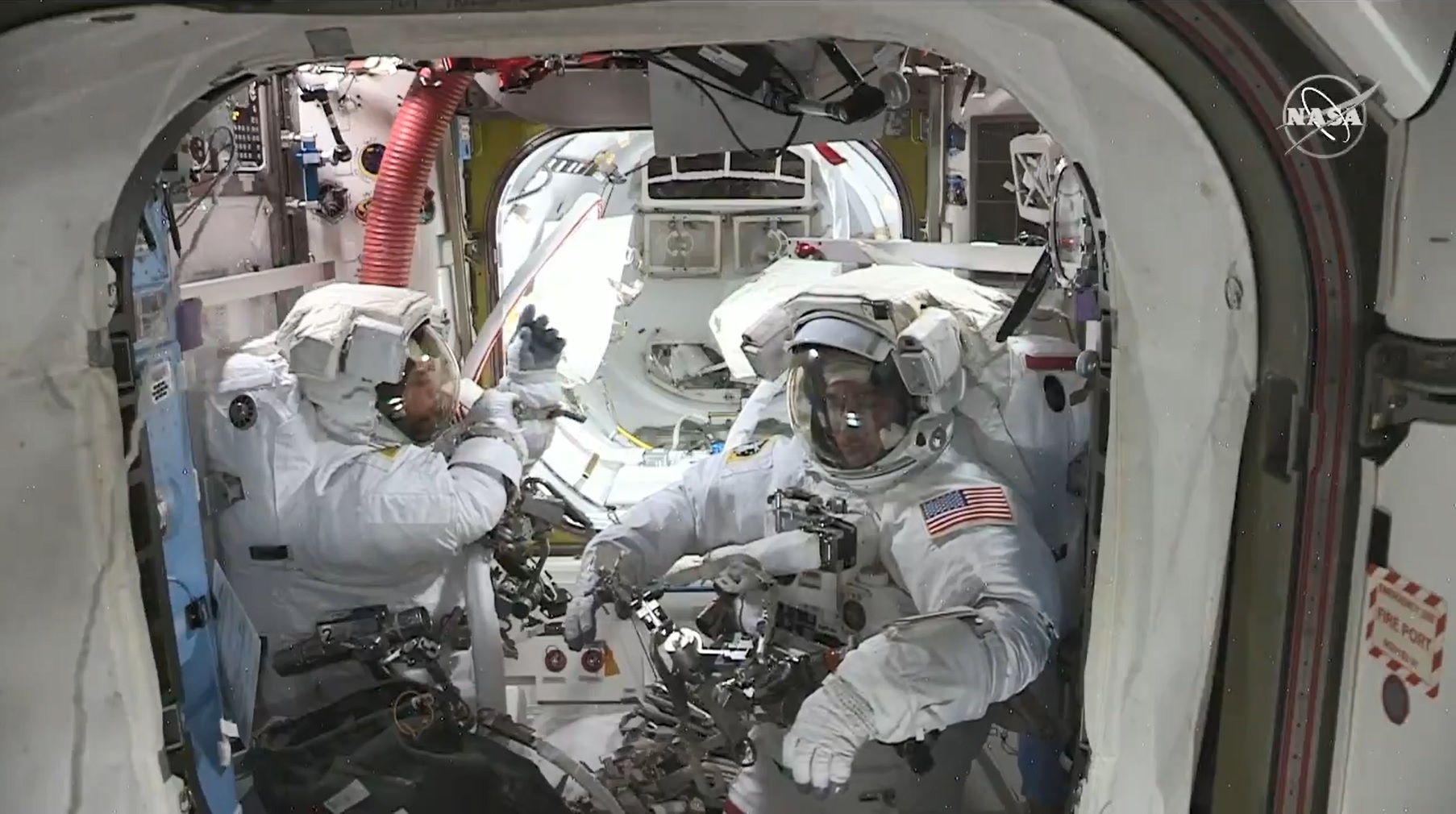Spacewalking astronauts tackle battery upgrade at space station
Two NASA astronauts began an epic battery swap in a spacewalk outside the International Space Station Friday (June 26), the first of four excursions to upgrade the outpost.
NASA astronauts Chris Cassidy and Bob Behnken, both veteran spacewalkers conducting their seventh extravehicular activity (EVA), swapped out three aging nickel-hydrogen batteries for two more efficient lithium-ion batteries, completing the work easily before their spacewalk concluded in 6 hours, 7 minutes at 1:39 p.m. EDT (1739 GMT)
The duo finished the work so quickly that in their fifth hour, they started get-ahead tasks for their next spacewalk, planned for Wednesday (July 1), which will include another set of battery replacements. During Friday's spacewalk, the duo removed two extra nickel-hydrogen batteries from service, batteries they were scheduled remove on July 1, and set them aside for future disposal.
Related: International Space Station at 20: A photo tour

The newly installed lithium-ion batteries were running well as the crew wrapped up their spacewalking tasks, according to a report on NASA Television during the spacewalk.
Behnken and Cassidy are among NASA's most experienced spacewalkers, having faced down their share of emergency and complex situations on EVAs. During Cassidy's last mission in 2013 (Expedition 35/36), he helped track down an urgent ammonia coolant rupture and assisted in rescuing European Space Agency astronaut Luca Parmitano from a potentially deadly spacesuit water leak. Behnken's last three spacewalks, during space shuttle mission STS-130 in 2010, saw him assist in installing the Tranquility module that houses the cupola wrap-around window, as well as exercise equipment and a toilet.
Friday's spacewalk was no less vital, as Cassidy and Behnken carefully removed and replaced S6 truss batteries that power one pair of space station solar arrays. Orbiting crews require power for just about everything they do in space, ranging from cooking to running experiments. The battery replacements are needed to power the space station through its planned mission extension to 2024. (Space station partners are discussing an extension through 2028 at the least as the orbiting laboratory opens up for more commercial opportunities. Some parts of the station are nearly 22 years old.)
Get the Space.com Newsletter
Breaking space news, the latest updates on rocket launches, skywatching events and more!
The astronauts switched to internal suit power at 7:32 a.m. EDT (1132 GMT), starting the spacewalk. Within minutes, the veteran spacewalkers were quickly moving outside and overcoming the usual small glitches that accompany maintenance work in space.
Cassidy's mirror on his left wrist inadvertently floated away as he exited the crew hatch into space, but it posed no risk to the astronauts or to the spacewalk procedures, officials said on NASA Television. Cassidy had a backup mirror on his right wrist to look at switches and actuators on his spacesuit not easily visible to him otherwise, officials added. Each mirror is only one tenth of a pound in mass.
Behnken, exiting the hatch close behind Cassidy, briefly struggled with a portable foot restraint (PFR) as he began to make his way to the worksite. "The PFR is sticky," Behnken commented while wrestling the device into his gloves for transportation.
Hand over hand, Behnken made his way first to the S6 truss with Cassidy lingering a little longer at a nearby external pallet in the grip of the robotic Canadarm2. The new, 428-lb. (194 kilograms) batteries were shipped to space aboard the ninth Japanese H-II Transfer Vehicle (HTV) in May, and moved to the worksite via robotic operations.
"OK, Bob, [I'm] finally getting your way," Cassidy said as he arrived at the truss, about 50 minutes into the spacewalk.
"That's good," Behnken answered.
Behnken and Cassidy (the latter wearing red stripes on his spacesuit designating him as lead spacewalker) worked closely together at a single work site for most of their excursion. For hours, the crew carefully worked back and forth between the truss and the battery area, moving the new batteries into place while storing the older batteries on a pallet for later disposal.
As the astronauts moved the bulky batteries around as a team, the duo carefully reminded each other who was controlling the movement, chanting directions back and forth. "I'm in control of the battery," one would say, every few seconds, with the other echoing, "You're in control."
The battery replacement was completed two hours ahead of schedule, with the astronauts moving into get-ahead tasks during the last part of the spacewalk. Besides intermittent radio communication issues and a sticky camera button, the astronauts reported their work went smoothly.
"My radio has been squirrelly," Behnken said at 4.5 hours into the spacewalk.
An hour later, Cassidy reported on struggles with a camera shutter. "Bob, I do not like this camera," he said while taking closeout photos of their worksite.
The space station orbit periodically brings it out of sunlight, requiring batteries to store and deploy electrical power as it flies in and out of orbital darkness 16 times a day. The nickel-hydrogen batteries only have about 6.5 years of useful life and require more frequent replacements than lithium-ion batteries, which are rated to last 10 years. The original batteries on the P6 truss, for example, were replaced with more nickel-hydrogen batteries in 2009 and 2010 before being upgraded to lithium ion a decade later.
The S6 truss location is quite far from the station's core, putting it out of the reach of robotic helpers and requiring spacewalkers to do most of the battery-replacement work. Replacements of closer-in batteries on the S4 and P4 trusses were mostly done through robotic operations, according to NASASpaceflight.com; by contrast, the further-out P6 truss battery replacements required extensive astronaut work in 2019 and 2020.

Replacing the space station's previous set of 48 nickel-hydrogen batteries with 24 lithium-ion ones has been a multi-year process for astronauts. The first set of lithium-ion battery-related spacewalks happened in 2017 and the matter was last tackled during a series of all-women spacewalks that finished in January 2020. If all goes to plan, Cassidy and Behnken will wrap up the battery replacements during their next spacewalk.
The spacewalkers were assisted by a team at mission control in Houston, including capcom (spacecraft communicator) and Canadian Space Agency astronaut David Saint-Jacques, and Ground IV (communicator to the spacewalking astronauts) NASA astronaut Jasmin Moghbeli. In space, NASA astronaut Doug Hurley was the suit-up lead, prompting a fond reminiscence from his wife and retired NASA astronaut, Karen Nyberg.
"The last time @Astro_SEAL [Chris Cassidy] did a spacewalk during Expedition 36, I was there to help him with suit-up and operations in the airlock," Nyberg said on Twitter on Thursday (June 25). "Tomorrow, it will be my husband's turn to get him and @AstroBehnken safely out the door!"
Cassidy, a former Navy SEAL, launched to space on a Russian Soyuz spacecraft on April 9 as part of Expedition 62. He is currently the space station commander for Expedition 63. Former U.S. Air Force test pilot Behnken flew into orbit on May 30, 2020 on the the Demo-2 mission, the first-ever SpaceX Crew Dragon spacecraft with astronauts on board. The Demo-2 launch from Florida was the first astronaut mission from the region since the last space shuttle mission, in 2011, and began NASA's long-awaited commercial crew program to replace the shuttle.
Friday's spacewalk was the 65th U.S. spacewalk and the 228th spacewalk overall in support of space-station assembly, maintenance and upgrades, according to NASA.
- In photos: The amazing spacewalks of Expedition 61
- In photos: SpaceX's historic Demo-2 test flight with astronauts
- Here's what SpaceX's 1st astronaut launch looked like from space (photo)
Follow Elizabeth Howell on Twitter @howellspace. Follow us on Twitter @Spacedotcom and on Facebook.
OFFER: Save 45% on 'All About Space' 'How it Works' and 'All About History'!
For a limited time, you can take out a digital subscription to any of our best-selling science magazines for just $2.38 per month, or 45% off the standard price for the first three months.
Join our Space Forums to keep talking space on the latest missions, night sky and more! And if you have a news tip, correction or comment, let us know at: community@space.com.

Elizabeth Howell (she/her), Ph.D., was a staff writer in the spaceflight channel between 2022 and 2024 specializing in Canadian space news. She was contributing writer for Space.com for 10 years from 2012 to 2024. Elizabeth's reporting includes multiple exclusives with the White House, leading world coverage about a lost-and-found space tomato on the International Space Station, witnessing five human spaceflight launches on two continents, flying parabolic, working inside a spacesuit, and participating in a simulated Mars mission. Her latest book, "Why Am I Taller?" (ECW Press, 2022) is co-written with astronaut Dave Williams.










